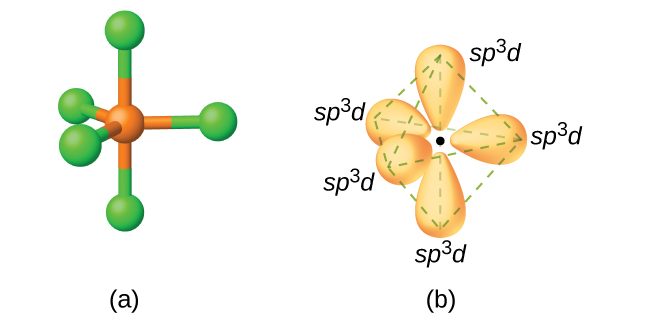To describe the five bonding orbitals in a trigonal bipyramidal arrangement, we must use five of the valence shell atomic orbitals. These include the s orbital, the three p orbitals, and one of the d orbitals. This combination results in five sp3d hybrid orbitals.
For an octahedral arrangement, we need six hybrid orbitals. This requires six valence shell atomic orbitals: the s orbital, the three p orbitals, and two of the d orbitals. This creates six sp3d2 hybrid orbitals. Such hybridizations are possible only for atoms with d orbitals in their valence subshells. This excludes atoms in the first and second period of the periodic table.
PCl5, SF4, ClF3 and ClF4 Hybridization
In a molecule of phosphorus pentachloride, PCl5, five P–Cl bonds direct five pairs of valence electrons from the phosphorus atom. These electrons point towards the corners of a trigonal bipyramid. To form the P-Cl bonds, we use the 3s orbital, the three 3p orbitals, and one of the 3d orbitals. This combination creates five sp3d hybrid orbitals ([link]). Other atoms that exhibit sp3d hybridization include the sulfur atom in SF4 and the chlorine atoms in ClF3 and in $ClF_4^+$.
(The electrons on fluorine atoms are omitted for clarity. However, you would need to include them in order for a question to be marked correctly. Your instructor will not know if you understand that they should be there.)


SF6 Hybridization
The sulfur atom in sulfur hexafluoride, SF6, exhibits sp3d2 hybridization. A molecule of sulfur hexafluoride has six bonding pairs of electrons connecting six fluorine atoms to a single sulfur atom. There are no lone pairs of electrons on the central atom. To bond six fluorine atoms, the 3s orbital, the three 3p orbitals, and two of the 3d orbitals combine. This process forms six equivalent sp3d2 hybrid orbitals, each directed toward a different corner of an octahedron. Other atoms that exhibit sp3d2 hybridization include the phosphorus atom in PCl6−,PCl6−,
the iodine atom in the interhalogens $IF_6^+$, $IF_5$, $ICl_4^−$, $IF_4^−$ and the xenon atom in $XeF_4$.
